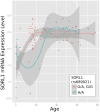The SORL1 gene and convergent neural risk for Alzheimer's disease across the human lifespan
- PMID: 24166411
- PMCID: PMC4004725
- DOI: 10.1038/mp.2013.142
The SORL1 gene and convergent neural risk for Alzheimer's disease across the human lifespan
Abstract
Prior to intervention trials in individuals genetically at-risk for late-onset Alzheimer's disease, critical first steps are identifying where (neuroanatomic effects), when (timepoint in the lifespan) and how (gene expression and neuropathology) Alzheimer's risk genes impact the brain. We hypothesized that variants in the sortilin-like receptor (SORL1) gene would affect multiple Alzheimer's phenotypes before the clinical onset of symptoms. Four independent samples were analyzed to determine effects of SORL1 genetic risk variants across the lifespan at multiple phenotypic levels: (1) microstructural integrity of white matter using diffusion tensor imaging in two healthy control samples (n=118, age 18-86; n=68, age 8-40); (2) gene expression using the Braincloud postmortem healthy control sample (n=269, age 0-92) and (3) Alzheimer's neuropathology (amyloid plaques and tau tangles) using a postmortem sample of healthy, mild cognitive impairment (MCI) and Alzheimer's individuals (n=710, age 66-108). SORL1 risk variants predicted lower white matter fractional anisotropy in an age-independent manner in fronto-temporal white matter tracts in both samples at 5% family-wise error-corrected thresholds. SORL1 risk variants also predicted decreased SORL1 mRNA expression, most prominently during childhood and adolescence, and significantly predicted increases in amyloid pathology in postmortem brain. Importantly, the effects of SORL1 variation on both white matter microstructure and gene expression were observed during neurodevelopmental phases of the human lifespan. Further, the neuropathological mechanism of risk appears to primarily involve amyloidogenic pathways. Interventions targeted toward the SORL1 amyloid risk pathway may be of greatest value during early phases of the lifespan.
Conflict of interest statement
Figures



Similar articles
-
Genetic epistasis regulates amyloid deposition in resilient aging.Alzheimers Dement. 2017 Oct;13(10):1107-1116. doi: 10.1016/j.jalz.2017.01.027. Epub 2017 Mar 17. Alzheimers Dement. 2017. PMID: 28322202 Free PMC article.
-
Effect of Alzheimer's Disease Risk Variant rs3824968 at SORL1 on Regional Gray Matter Volume and Age-Related Interaction in Adult Lifespan.Sci Rep. 2016 Mar 21;6:23362. doi: 10.1038/srep23362. Sci Rep. 2016. PMID: 26996954 Free PMC article.
-
Association between genetic variants in sortilin-related receptor 1 (SORL1) and Alzheimer's disease in adults with Down syndrome.Neurosci Lett. 2007 Sep 25;425(2):105-9. doi: 10.1016/j.neulet.2007.08.042. Epub 2007 Aug 25. Neurosci Lett. 2007. PMID: 17826910 Free PMC article.
-
The neuronal sortilin-related receptor gene SORL1 and late-onset Alzheimer's disease.Curr Neurol Neurosci Rep. 2008 Sep;8(5):384-91. doi: 10.1007/s11910-008-0060-8. Curr Neurol Neurosci Rep. 2008. PMID: 18713574 Free PMC article. Review.
-
The Role of SORL1 in Alzheimer's Disease.Mol Neurobiol. 2015;51(3):909-18. doi: 10.1007/s12035-014-8742-5. Epub 2014 May 16. Mol Neurobiol. 2015. PMID: 24833601 Review.
Cited by
-
Sortilin Is Upregulated in Osteoarthritis-Dependent Cartilage Calcification and Associated with Cellular Senescence.Int J Mol Sci. 2023 Aug 2;24(15):12343. doi: 10.3390/ijms241512343. Int J Mol Sci. 2023. PMID: 37569721 Free PMC article.
-
Dysregulation of Rab5-mediated endocytic pathways in Alzheimer's disease.Traffic. 2018 Apr;19(4):253-262. doi: 10.1111/tra.12547. Epub 2018 Feb 5. Traffic. 2018. PMID: 29314494 Free PMC article. Review.
-
Informatics Support for Basic Research in Biomedicine.ILAR J. 2017 Jul 1;58(1):80-89. doi: 10.1093/ilar/ilx004. ILAR J. 2017. PMID: 28838071 Free PMC article. Review.
-
[Verification of a sporadic Alzheimer disease model in SORL1 gene knockout mice].Nan Fang Yi Ke Da Xue Xue Bao. 2018 Mar 20;38(3):289-295. doi: 10.3969/j.issn.1673-4254.2018.03.08. Nan Fang Yi Ke Da Xue Xue Bao. 2018. PMID: 29643034 Free PMC article. Chinese.
-
Genetic epistasis regulates amyloid deposition in resilient aging.Alzheimers Dement. 2017 Oct;13(10):1107-1116. doi: 10.1016/j.jalz.2017.01.027. Epub 2017 Mar 17. Alzheimers Dement. 2017. PMID: 28322202 Free PMC article.
References
-
- Prince M, Jackson J. Alzheimer's Disease International World Alzheimer Report 2009 [Internet] Alzheimer's Disease International. 2009 [cited 2012]. Available from: http://www.alz.co.uk/research/files/WorldAlzheimerReport.pdf.
-
- Fox N. When, where, and how does Alzheimer's disease start? The Lancet Neurology [Internet] 2012 [cited 2012];Available from: http://www.thelancet.com/journals/laneur/article/PIIS1474-4422(12)70256-.... - PubMed
-
- Reiman EM, Quiroz YT, Fleisher AS, Chen K, Velez-Pardo C, Jimenez-Del-Rio M, et al. Brain imaging and fluid biomarker analysis in young adults at genetic risk for autosomal dominant Alzheimer's disease in the presenilin 1 E280A kindred: a case-control study. The Lancet Neurology[Internet] 2012 [cited 2012];Available from: http://www.thelancet.com/journals/laneur/article/PIIS1474-4422(12)70228-.... - PMC - PubMed
-
- Felsky D, Voineskos AN. APoe ∈ 4, aging, and effects on white matter across the adult life span. JAMA Psychiatry. 2013;70:646–647. - PubMed
Publication types
MeSH terms
Substances
Grants and funding
- R01 MH099167/MH/NIMH NIH HHS/United States
- R01 AG030146/AG/NIA NIH HHS/United States
- CAPMC/ CIHR/Canada
- P50MH080173/MH/NIMH NIH HHS/United States
- R01MH099167/MH/NIMH NIH HHS/United States
- P50 MH080173/MH/NIMH NIH HHS/United States
- R01AG15819/AG/NIA NIH HHS/United States
- P30AG10161/AG/NIA NIH HHS/United States
- R01 AG015819/AG/NIA NIH HHS/United States
- R01 AG017917/AG/NIA NIH HHS/United States
- R01AG17917/AG/NIA NIH HHS/United States
- P30 AG010161/AG/NIA NIH HHS/United States
- R01AG30146/AG/NIA NIH HHS/United States
LinkOut - more resources
Full Text Sources
Other Literature Sources
Medical

